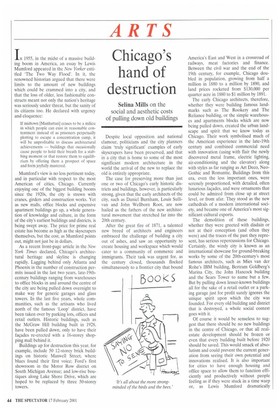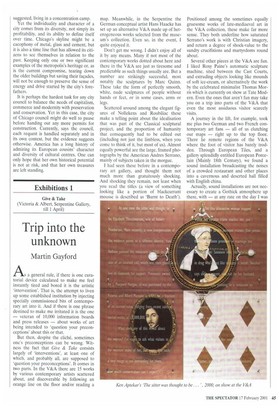Chicago's hand of destruction
Selina Mills on the social and aesthetic costs of pulling down old buildings
In 1955, in the midst of a massive building boom in America, an essay by Lewis Mumford appeared in the New Yorker entitled The Two Way Flood'. In it, the renowned historian argued that there were limits to the amount of new buildings which could be crammed into a city, and that the loss of older, less fashionable constructs meant not only the nation's heritage was seriously under threat, but the sanity of its citizens too. He declared with urgency and eloquence: If midtown [Manhattan] ceases to be a milieu in which people can exist in reasonable contentment instead of as prisoners perpetually plotting to escape a concentration camp, it will be unprofitable to discuss architectural achievements — buildings that occasionally cause people to hold their breath for a stabbing moment or that restore them to equilibrium by offering them a prospect of space and form joyfully mastered.
Mumford's view is no less pertinent today, and in particular with respect to the most American of cities, Chicago. Currently enjoying one of the biggest building booms since the 1920s, the city is strewn with cranes, girders and construction works. Yet as new malls, office blocks and expensive apartment buildings go up, a whole generation of knowledge and culture, in the form of the city's earliest buildings and districts, is being swept away. The price for prime real estate has become as high as the skyscrapers themselves, but the cost, as Mumford points out, might not just be in dollars.
As a recent front-page article in the New York Times declared, Chicago's architectural heritage and skyline is changing rapidly. Lagging behind only Atlanta and Phoenix in the number of construction permits issued in the last two years, late-19thcentury buildings ranging from warehouses to office blocks in and around the centre of the city are being pulled down overnight to make way for generic garages and glass towers. In the last five years, whole communities, such as the artisans who lived north of the famous 'Loop' district, have been taken over by parking lots, offices and retail outlets. Historic buildings, such as the McGraw Hill building built in 1928, have been pulled down, only to have their facades re-erected with a 16-storey shopping mall behind it.
Buildings up for destruction this year, for example, include 50 12-storey brick buildings on historic Maxwell Street, where blues found their first voice; Ford's first showroom in the Motor Row district on South Michigan Avenue; and low-rise boutiques along Lake Shore Drive, which are hoped to be replaced by three 50-storey towers. Despite local opposition and national clamour, politicians and the city planners claim 'truly significant' examples of early skyscrapers have been preserved, and that in a city that is home to some of the most significant modern architecture in the world the arrival of the new to replace the old is entirely appropriate.
The case for preserving more than just one or two of Chicago's early historic districts and buildings, however, is particularly strong, given that the early architects of the city, such as Daniel Burnham, Louis Sullivan and John Wellborn Root, are now hailed as the fathers of the new architectural movement that stretched far into the 20th century.
After the great fire of 1871, a talented new breed of architects and engineers embraced the challenge of building a city Out of ashes, and saw an opportunity to create housing and workspace which would cater to a community of commerce and immigrants. Their task was urgent for, as the century closed, thousands flocked simultaneously to a frontier city that bound
America's East and West in a crossroad of railways, meat factories and finance. Between the civil war and the end of the 19th century, for example, Chicago doubled in population, growing from half a million in 1880 to a million by 1890, and land prices rocketed from $130,000 per quarter acre in 1880 to $1 million by 1891.
The early Chicago architects, therefore, whether they were building famous landmarks such as The Rookery and The Reliance building, or the simple warehouses and apartments blocks which are now being pulled down, created the urban landscape and spirit that we know today as Chicago. Their work symbolised much of the American experience in the late-19th century and combined commercial need with innovation (using with flair the newly discovered metal frame, electric lighting, air-conditioning and the elevator) along with styles as far ranging as Art Deco, NeoGothic and Romantic. Buildings from this era, even the less important ones, were serenely proportioned, with detailed, often luxurious facades, and were ornaments that could be admired from close up at street level, or from afar. They stood as the new cathedrals of a modern international society, and became one of America's most significant cultural exports.
The demolition of these buildings, whether they were greeted with disdain or not at their conception (and often they were) and the traces of the past they represent, has serious repercussions for Chicago. Certainly, the windy city is known as an international showcase for ground-breaking works by some of the 20th-century's most famous architects, such as Mies van der Rohe's IBM building, Bertram Goldberg's Marina City, the John Hancock building and the Sears Tower to name but a few. But by pulling down lesser-known buildings all for the sake of a retail outlet or a parking garage just for profit surely ignores the unique spirit upon which the city was founded. For every old building and district that is destroyed, a whole social context goes with it.
Of course it would be senseless to suggest that there should be no new buildings in the centre of Chicago, or that all realestate development should be frozen or even that every building built before 1920 should be saved. This would smack of absolutism and could prevent the current generation from seeing their own potential and innovations realised. It is also important for cities to have enough housing and office space to allow them to function efficiently and productively without people feeling as if they were stuck in a time warp or, as Lewis Mumford dramatically suggested, living in a concentration camp.
Yet the individuality and character of a city comes from its diversity, not simply its profitability, and its ability to define itself over time. Chicago's skyline might be a cacophony of metal, glass and cement, but it is also a time line that has allowed its citizens to see themselves in relation to the past. Keeping only one or two significant examples of the metropolis's heritage or, as is the current compromise, tearing down the older buildings but saving their façades, will not be enough to preserve the sense of energy and drive started by the city's forefathers.
It is perhaps the hardest task for any city council to balance the needs of capitalism, commerce and modernity with preservation and conservation. Yet in this case, the city of Chicago council might do well to pause before handing out any more permits for construction. Currently, says the council, each request is handled separately and in its own context, but the evidence suggests otherwise. America has a long history of admiring its European cousins' character and diversity of cultural centres. One can only hope that her own historical potential is not at risk, and that her own treasures are left standing.



































































 Previous page
Previous page